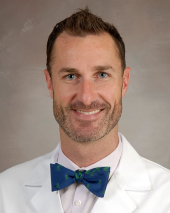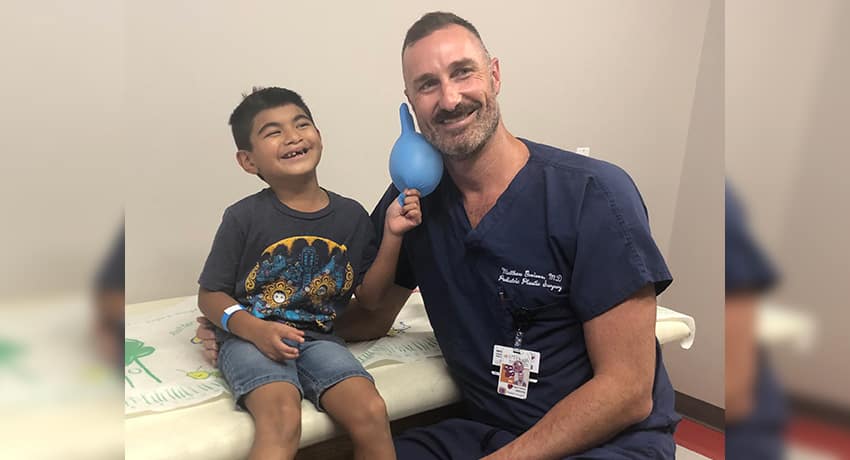The first time Sonia Estrada saw her son Jae blow a bubble, it brought tears to her eyes.
It marked a major milestone for the now 7-year-old Jae, who was born with a cleft lip and palate – birth defects that occur when a baby’s lip or mouth do not form properly during pregnancy.
“I felt like I did something wrong, but the doctor reassured me there was nothing I could have done to prevent it,” said Estrada, who learned about five months into her pregnancy that her son would be born with the birth defects. “I had no previous knowledge about what it was. I had to learn everything.”
About one in every 1,600 babies is born with cleft lip and palate in the U.S. annually, according to the Centers for Disease Control and Prevention. Children with the birth defects often have problems with feeding and speaking clearly, and are at higher risk for ear infections, hearing deficits, and dental problems.
Before Jae was born, Estrada’s OB-GYN told her that she would need to find a cleft team because her son would require multiple surgeries. Estrada was lined up with an expert team at Children’s Memorial Hermann Hospital-Texas Medical Center.
Care from day one
When Jae arrived on July 15, 2014, a coordinator visited the baby in the neonatal intensive care unit (NICU) and Estrada in the recovery room at Children’s Memorial Hermann Hospital. It was the coordinator’s day off, which touched the new mother.
“That just made the decision so easy for me,” Estrada said. “I didn’t have to think twice about where I was going to go and which doctor I was going to see.”

The coordinator arranged an appointment between Estrada and Matthew Greives, MD, the Dr. Thomas D. Cronin Chair in Plastic Surgery and an associate professor in the Department of Pediatric Surgery with McGovern Medical School at UTHealth Houston. Greives is a pediatric plastic surgeon with UT Physicians – the clinical practice of UTHealth Houston – and Children’s Memorial Hermann Hospital.
At the time, Greives was a brand-new recruit to UTHealth Houston, and he told Estrada that if she did not feel comfortable with him as Jae’s plastic surgeon, he could point her to another doctor. But the longer Estrada talked to Greives, the more comfortable she felt, and she decided to move forward with the game plan that Greives had laid out for her newborn child.
“Because cleft lip and palate is such a visible defect, it often leads people to incorrectly believe that there’s something wrong with the child mentally or physically,” said Greives, who is now the director of the Texas Cleft-Craniofacial Team, one of the largest and longest-running cleft teams in the state of Texas. “But as we get better at doing surgery, these kids are far more likely to develop normally and play sports, go to school, and have friends. So while it is very visible, it is absolutely treatable, and it’s not as scary as it initially seems.”
Greives initially tried to design a retainer from a mold of Jae’s lip and nose in an effort to help close his cleft lip. However, after Jae had some feeding issues with the retainer, Greives switched course and performed a cleft lip repair, also known as cheiloplasty, in two stages.
“In the first-stage surgery, when Jae was around 3 months old, we glued the lip together,” Greives said. “Then, when he was 5 or 6 months old, we performed a full cleft lip repair.”
During the surgery, Greives was able to reconstruct Jae’s upper lip, giving it a more normal appearance by closing the cleft, forming the curves along the center of the lip, and creating an adequate distance between his upper lip and nose.
When Jae turned 1 year old, Greives performed another procedure to repair his cleft palate, which occurs when the floor of the nasal cavity, responsible for allowing normal speech, does not close properly. The surgery closes the palate.
Over the years that followed, Greives saw Jae for annual checkups. But it wasn’t until December 2021 that Jae had another procedure; this time, a bone graft surgery to repair his gumline and jaw.
“We try to delay bone graft surgeries until the adult teeth start coming in, which is usually around age 6 or 7,” Greives said. “It’s all about protecting Jae’s adult teeth.”
On the right track
So far, Jae is responding well to his most recent surgery. A CT scan in May will determine next steps for Jae, including whether or not he will be able to get braces.
Today, the energetic second-grader, who loves math and is quick to protect his infant cousins, is still dealing with some dental issues and remains in speech therapy. But every time Jae blows a bubble or eats ramen – now one of his favorite dishes – Estrada smiles at seeing how far he has progressed.
Regardless of what the CT scan shows, Estrada is grateful for the care Jae has received and optimistic toward what his future holds.
“He’s on the right track with all these procedures,” Estrada said. “Because Dr. Greives is so honest with me and doesn’t sugarcoat anything, it makes me feel a lot better. Parents who have a child with cleft lip and palate should know that this process is going to be hard in the beginning, and you’re going to feel like you can’t do it anymore, but it will be worth it in the end.”



